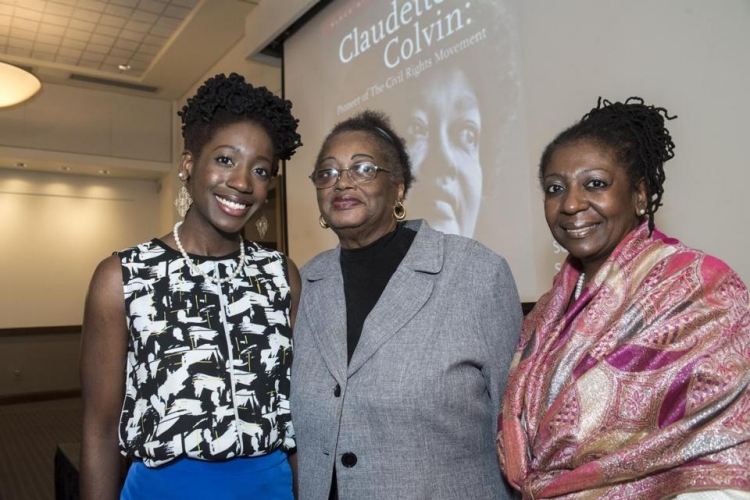
By
There are things Claudette Colvin simply can’t, or won’t, forget about being a black child in mid-20th century Montgomery, Alabama: having to draw a diagram of your feet to take to the shoe store, because you weren’t permitted to try on shoes; not being allowed to ride the coin-operated rocking horse at the local five-and-dime store, or to even touch the toys on the shelves.
These experiences, Colvin recalled at a Boston College event last week, were etched in her mind on the day 60 years ago she made a decision that changed her life – and helped change history as well. Refusing to give up her seat to a white woman on a segregated bus, Colvin was arrested and thrown in jail. She was 15 years old.
Now a retired grandmother of five, Colvin was honored as a civil rights pioneer at the Feb. 19 event, sponsored by the BC School of Social Work, where her granddaughter Jennifer is a student. Jennifer and her mother, Cheryl – a co-organizer of the 50th anniversary commemoration of the Selma-Montgomery civil rights march – were both on hand for Colvin’s talk, which took place in the Heights Room of Corcoran Commons.
For decades, Colvin’s act of defiance was overshadowed by that of Rosa Parks, even though it occurred nine months before Parks’ similar refusal to heed Montgomery’s bus segregation laws attracted international attention. But in recent years, Colvin has shared her story, through the book Claudette Colvin: Twice Toward Justice, authored by Phillip Hoose, as well as via interviews with the media and through personal appearances.
“People have called me an ‘unsung hero’ of civil rights,” Colvin told the audience. “But I think of myself as a survivor, because so many lives were sacrificed in the cause of civil rights. In spite of all the obstacles, I am still here to tell my story.”
Colvin recounted the events of that historic day – March 2, 1955 – and how she had boarded the bus in front of the church where Martin Luther King Jr. was pastor. In school that day, her class had discussed the impact of Jim Crow segregation laws on their daily lives, and when the bus driver ordered her to give up her seat for a white passenger, Colvin said, “I remained where I was, because history had me glued to the seat.
“I felt like Sojourner Truth was on one side, and Harriet Tubman on the other, holding me down. That’s why I didn’t move.”
Colvin said she explained to the bus driver, and the police officers who came to arrest her, that she had paid her fare and had a constitutional right to retain her seat. The officers escorted her off the bus and into a squad car, and instead of taking her to juvenile court brought Colvin to the city jail – during the ride, she recalled in Twice Toward Justice, the officers called her names and made remarks about her body – where she spent three hours until her mother bailed her out.
“It was like an old Western movie – when the door to the jail cell closed you heard the lock click – and fear came over me,” Colvin said. “Because I’m Baptist, I started praying. I recited the 23rd Psalm and the Lord’s Prayer.”
Her parents were not pleased with what she had done, Colvin noted. Her father told her she had “brought a lot of danger on us” and loaded his shotgun; the neighborhood was convinced there would be reprisals from the Ku Klux Klan. But none came: “My mother said God was protecting me.”
Almost a year later, Colvin agreed to be come a plaintiff in a federal civil action lawsuit against the Montgomery and Alabama bus segregation laws. She and her fellow plaintiffs won in district court, and their victory was upheld by the US Supreme Court in November of 1956.
In the months between Colvin’s arrest and the start of the federal lawsuit, Rosa Parks had made her own stand against segregation, and would become an important symbol of the struggle for civil rights. Historians have cited several reasons why Parks received more attention and support, not least because she was secretary of the local NAACP; an adult with good standing in the community, she was therefore thought likely to be more reliable and sympathetic in the public eye than a rebellious teenager.
In fact, Parks knew Colvin and her family, and helped Colvin raise money for her court case. But their familiarity went beyond civil rights matters: Colvin recalled serving as a mannequin once to aid Parks, a seamstress, in creating a wedding gown; Parks’ mother would bake cookies and enlist Colvin to sell them around the neighborhood.
Colvin also engaged in a Q&A session at the event. Asked what advice she would give to young people concerned about social justice, she replied, “Where there’s injustice, speak up. And get yourself an education and use it as a tool to get you where you want to go. Vote locally, not just for president, to better your community and your quality of life.”
She remarked on the importance of passing along the personal side of civil rights history, to help younger people appreciate how far the struggle has come, even though “we still have a long way to go.”
“I’ve seen the change,” said Colvin. “I’ve seen the fruit of my labor, not just for my children but all African-American children.”



